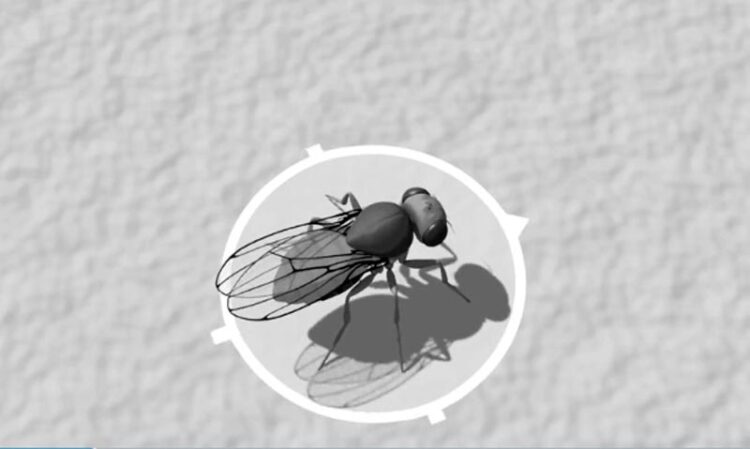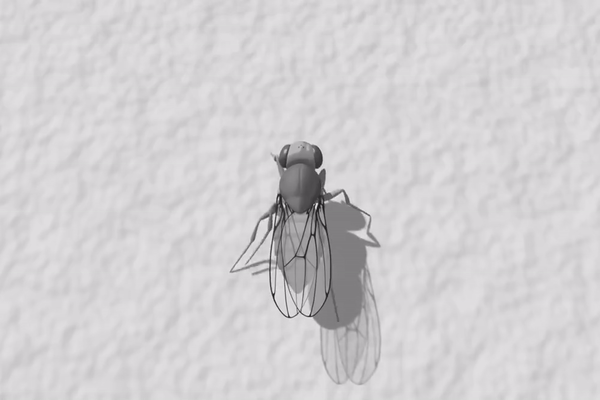How fruit flies control the brain’s “steering wheel”

New research explains how a neural circuit steers flies towards their goal.
Credit: Samantha DeSouto/The Rockefeller University
When we walk down the street, we have an internal sense of which way we are heading, from looking at street signals and physical landmarks, and also a sense of where we’d like to go. But how does the brain coordinate between these directions, doing the mental math that tells us which way to turn?
Now, new research describes such a neural process in fruit flies, providing insight into how an animal’s brain steers it in the right direction. The study, published in Nature , shows how neurons that signal the direction in which a fly is currently oriented work together with neurons that signal the direction in which way the fly wishes to be oriented—its goal direction—to form a circuit that guides the animal.
“The fundamental question is how brains enable navigation,” says Rockefeller’s Gaby Maimon. “In this study, we describe neurons that provide goal-direction signals, alongside a brain circuit that uses these signals to direct steering.”
Navigational goals
The cells responsible for signaling which way a fly is oriented in the world (known as “compass” neurons) were first discovered in 2015. A few years later, work from the Maimon lab and others demonstrated that flies with defective compass neurons are unable to navigate in a straight line along any arbitrary goal direction. Building on that discovery, Peter Mussells Pires, a student in Maimon’s lab and the lead author on this paper, set out to discover the cells responsible for keeping track of a fly’s goal angle.
 New research explains how a neural circuit steers flies towards their goal. (Samantha DeSouto)
New research explains how a neural circuit steers flies towards their goal. (Samantha DeSouto)
Pires and colleagues used two-photon microscopy to monitor flies’ neurons while the insects walked on an air-levitated ball in a virtual environment. Whenever the researchers rotated the virtual environment, the activity of the fly’s compass neurons rotated in the brain as well. Interestingly, however, a population of cells, identified as FC2 neurons, remained unmoved and focused on the original heading.
“Imagine walking uptown in Manhattan, and someone pulls your shoulder and turns you east. Something in your brain continues to track which way is north, so that you can return to your original heading,” Maimon explains. “In flies, these are FC2 neurons.”
To confirm the role of FC2 neurons in tracking a goal, the team used optogenetics—a technique that uses light to control the activity of neurons. By manipulating the activity of FC2 cells, the researchers were able to change the fly’s navigation direction in predictable ways. “This was the experiment that really convinced us that these cells can actually determine the fly’s goal,” Pires says.
Mental math
With heading neurons and goal neurons identified, the team shifted its focus to the brain circuit responsible for combining the two signals. Recent work fleshing out the fly brain connectome—a map detailing the connections between different neurons—helped the researchers zero in on the circuit in question. The connectome made clear that a set of cells, called PFL3 cells, receive inputs from both the compass and goal neurons.
A series of experiments confirmed that PFL3 neurons tell the fly’s body which way to turn by influencing the brain’s motor system. They do so by comparing internal heading and goal inputs, functioning a bit like the steering wheel of the fly’s navigation system. Larry Abbott, a theorist at Columbia University, collaborated with the team to develop a mathematical understanding of the system. Abbott’s model captured how compass and goal signals, which are represented in world or map coordinates (for example, north/east/south/west), are converted into motor-related signals in the body’s coordinate system—that is, left and right turns. Complementary results on PFL neurons, closely tied to the present study, are detailed in a parallel Nature paper.
Future work from the Maimon lab will focus on how flies build and store longer term spatial memories and goals to guide behavior; the goal signal characterized in this study only explains what the flies will do in the next few seconds. Maimon is also curious to learn whether these new findings might catalyze the discovery of similar brain circuits in mammals and ultimately humans.
“By studying the fly brain”, he says, “we have provided an initial glimpse into how a simple ‘thought’ is converted into an action. Hopefully, these findings will allow us to understanding more complex forms of this process in mammals down the road.”
Journal: Nature
DOI: 10.5281/zenodo.10232698
Article Title: Converting an allocentric goal into an egocentric steering signal
Media Contact
Katherine Fenz
Rockefeller University
kfenz@rockefeller.edu
Office: 212-327-7913
All latest news from the category: Life Sciences and Chemistry
Articles and reports from the Life Sciences and chemistry area deal with applied and basic research into modern biology, chemistry and human medicine.
Valuable information can be found on a range of life sciences fields including bacteriology, biochemistry, bionics, bioinformatics, biophysics, biotechnology, genetics, geobotany, human biology, marine biology, microbiology, molecular biology, cellular biology, zoology, bioinorganic chemistry, microchemistry and environmental chemistry.
Newest articles

Trotting robots reveal emergence of animal gait transitions
A four-legged robot trained with machine learning by EPFL researchers has learned to avoid falls by spontaneously switching between walking, trotting, and pronking – a milestone for roboticists as well…

Innovation promises to prevent power pole-top fires
Engineers in Australia have found a new way to make power-pole insulators resistant to fire and electrical sparking, promising to prevent dangerous pole-top fires and reduce blackouts. Pole-top fires pose…

Possible alternative to antibiotics produced by bacteria
Antibacterial substance from staphylococci discovered with new mechanism of action against natural competitors. Many bacteria produce substances to gain an advantage over competitors in their highly competitive natural environment. Researchers…
 New research explains how a neural circuit steers flies towards their goal. (Samantha DeSouto)
New research explains how a neural circuit steers flies towards their goal. (Samantha DeSouto)




















